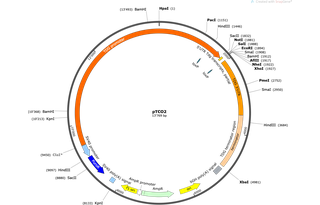pTCO2
(Plasmid
#149428)
-
Purpose(Empty Backbone) cloning vector with regulatory regions of the murine Tdg gene
-
Depositing Lab
-
Sequence Information
Ordering
| Item | Catalog # | Description | Quantity | Price (USD) | |
|---|---|---|---|---|---|
| Plasmid | 149428 | Standard format: Plasmid sent in bacteria as agar stab | 1 | $85 | |
Backbone
-
Vector backbonepBluescript
-
Backbone manufacturerStratagene
- Backbone size (bp) 3000
-
Modifications to backbonemultiple cloning steps to generate a mammalian expression vector containing (1) about 6 and 3 kb of the promoter and the 3'UTR/terminator sequences of murine TDG (https://www.ncbi.nlm.nih.gov/gene/21665), respectively, (2) puromycin selection marker controlled by the SV40 promoter/poly(A) signal, and (3) two loxP sites in the Tdg promoter and 3' of the MCS
-
Vector typeMammalian Expression, Cre/Lox
- Promoter murine Tdg promoter
-
Selectable markersPuromycin
Growth in Bacteria
-
Bacterial Resistance(s)Ampicillin, 100 μg/mL
-
Growth Temperature30°C
-
Growth Strain(s)DH5alpha
-
Copy numberHigh Copy
Cloning Information
- Cloning method Restriction Enzyme
- 5′ sequencing primer M13/pUC forward
- 3′ sequencing primer M13/pUC reverse (Common Sequencing Primers)
Resource Information
-
Supplemental Documents
Terms and Licenses
-
Academic/Nonprofit Terms
-
Industry Terms
- Not Available to Industry
Trademarks:
- Zeocin® is an InvivoGen trademark.
These plasmids were created by your colleagues. Please acknowledge the Principal Investigator, cite the article in which the plasmids were described, and include Addgene in the Materials and Methods of your future publications.
-
For your Materials & Methods section:
pTCO2 was a gift from Primo Schaer (Addgene plasmid # 149428 ; http://n2t.net/addgene:149428 ; RRID:Addgene_149428) -
For your References section:
Inducible TDG knockout models to study epigenetic regulation. Schwarz SD, Grundbacher E, Hrovat AM, Xu J, Kusnierczyk A, Vagbo CB, Schar P, Schuermann D. F1000Res. 2020 Sep 9;9:1112. doi: 10.12688/f1000research.25637.2. eCollection 2020. 10.12688/f1000research.25637.2 PubMed 33082936





